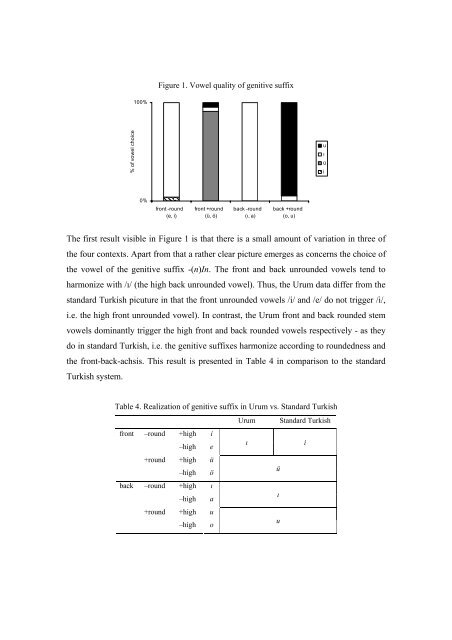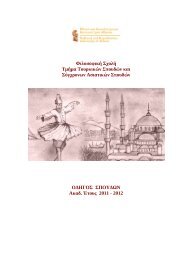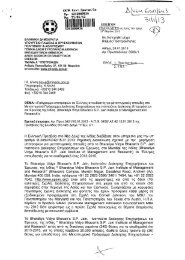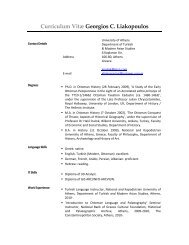Vowel harmony and noun inflection in Caucasian Urum
Vowel harmony and noun inflection in Caucasian Urum
Vowel harmony and noun inflection in Caucasian Urum
You also want an ePaper? Increase the reach of your titles
YUMPU automatically turns print PDFs into web optimized ePapers that Google loves.
Figure 1. <strong>Vowel</strong> quality of genitive suffix100%% of vowel choiceuıüi0%front -round(e, i)front +round(ü, ö)back -round(ı, a)back +round(o, u)The first result visible <strong>in</strong> Figure 1 is that there is a small amount of variation <strong>in</strong> three ofthe four contexts. Apart from that a rather clear picture emerges as concerns the choice ofthe vowel of the genitive suffix -(n)In. The front <strong>and</strong> back unrounded vowels tend toharmonize with /ı/ (the high back unrounded vowel). Thus, the <strong>Urum</strong> data differ from thest<strong>and</strong>ard Turkish picuture <strong>in</strong> that the front unrounded vowels /i/ <strong>and</strong> /e/ do not trigger /i/,i.e. the high front unrounded vowel). In contrast, the <strong>Urum</strong> front <strong>and</strong> back rounded stemvowels dom<strong>in</strong>antly trigger the high front <strong>and</strong> back rounded vowels respectively - as theydo <strong>in</strong> st<strong>and</strong>ard Turkish, i.e. the genitive suffixes harmonize accord<strong>in</strong>g to roundedness <strong>and</strong>the front-back-achsis. This result is presented <strong>in</strong> Table 4 <strong>in</strong> comparison to the st<strong>and</strong>ardTurkish system.Table 4. Realization of genitive suffix <strong>in</strong> <strong>Urum</strong> vs. St<strong>and</strong>ard Turkish<strong>Urum</strong> St<strong>and</strong>ard Turkishfront –round +high iıi–high e+round +high üü–high öback –round +high ıı–high a+round +high uu–high o









![Panagiotis C. Poulos[cv]](https://img.yumpu.com/6513871/1/190x245/panagiotis-c-pouloscv.jpg?quality=85)